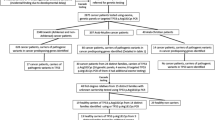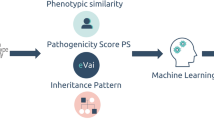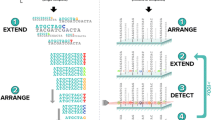Abstract
Predictive carrier testing for the inherited disorder of familial adenomatous polyposis (FAP) can be conducted using DNA markers linked to the FAP locus. The presence of characteristic hypertrophic retinal lesions has been advocated as useful biomarkers for FAP. We have compared molecular linkage and retinal screening techniques by evaluating the presymptomatic carrier risk of 40 at-risk individuals from 15 FAP families. Linkage analysis was informative in all and retinal lesion analysis in 25 cases. For informative at-risk population, predictive diagnosis by both techniques was completely concordant and identified 15 members at “high” and 10 at “low” risk of inheriting FAP. Because of the unique advantages offered by each technique, a strategy integrating both techniques will increase the number of FAP families that can be screened presymptomatically. Identification of individuals at high risk of polyposis will improve their clinical surveillance and further reduce the incidence of colorectal cancer in FAP families.
Similar content being viewed by others
References
Bussey HJ. Familial polyposis coli. Family studies, histopathology, differential diagnosis, and results of treatment. Baltimore: Johns Hopkins University Press, 1975.
Gardner EJ, Richards RC. Multiple cutaneous and subcutaneous lesions occurring simultaneously with hereditary polyposis and osteomatosis. Am J Human Genet 1953;5:139–47.
Traboulsi EI, Krush AJ, Gardner EJ,et al. Prevalence and importance of pigmented ocular fundus lesions in Gardner's syndrome. N Engl J Med 1987;316:661–7.
Blair NP, Trempe CL. Hypertrophy of the retinal pigment epithelium associated with Gardner's syndrome. Am J Ophthalmol 1980;90:661–7.
Leppard BJ, Bussey HJ. Epidermoid cysts, polyposis coli and Gardner's syndrome. Br J Surg 1975;62:387–93.
Sondergaard JO, Bulow S, Jarvinen H, Wolf J, Witt IN, Tetens G. Dental anomalies in familial polyposis coli. Acta Odontol Scand 1987;45:61–3.
Iida M, Yao T, Watanabe H, Itoh H, Iwashita A. Fundic gland polyposis in patients without familial adenomatosis coli: its incidence and clinical features. Gastroenterology 1984;86:1437–42.
Jones IT, Fazio VW, Weakly FL, Jagelman DG, Lavery IC, McGannon E. Desmoid tumors in familial polyposis coli. Ann Surg 1986;204:94–7.
Romania A, Zakov N, McGannon BS, Schroeder T, Heyen F, Jagelman DG. Congenital hypertrophy of the retinal pigment epithelium in familial adenomatous polyposis. Ophthalmology 1989;96:879–84.
Bodmer WF, Bailey CJ, Bodmer J,et al. Localization of the gene for familial polyposis coli on chromosome 5. Nature 1987;328:614–6.
Leppert M, Dobbs M, Scambler P,et al. The gene for familial adenomatous polyposis maps to the long arm of chromosome 5. Science 1987;238:1411–3.
Nakamura Y, Lathrop M, Leppert M,et al. Localization of the genetic defect in familial adenomatous polyposis within a small region of chromosome 5. Am J Hum Genet 1988;43:638–44.
Tops CM, Wijnen JT, Griffioen G,et al. Presymptomatic diagnosis of familial adenomatous polyposis by bridging DNA markers. Lancer 1989;2:1361–3.
Dunlop MG, Wyllie AH, Nakamura Y,et al. Genetic linkage map of six polymorphic DNA markers around the gene for familial adenomatous polyposis on chromosome 5. Am J Hum Genet 1990;47:982–7.
Groden J, Thilveris A, Samowitz W,et al. Identification and characterization of the familial adenomatous polyposis coli gene. Cell 1991;66:589–600.
Kinzler KW, Nilbert MC, Su LK,et al. Identification of FAP locus genes from chromosome 5q21. Science 1991;253:661–5.
Joslyn G, Carlson M, Thilveris A,et al. Identification of deletion mutations and three new genes at the familial polyposis locus. Cell 1991;66:601–13.
Nishisho I, Nakamura Y, Miyoshi Y,et al. Mutations of chromosomes 5q21 genes in FAP and colorectal cancer patients. Science 1991;253:665–9.
Miyoshi Y, Ando H, Nagase H,et al. Germ-line mutations of the APC gene in 53 familial adenomatous polyposis patients. Proc Natl Acad Sci USA 1992;89:4452–6.
Dunlop MG, Wyllie AH, Steel CM, Piris J, Evans HJ. Linked DNA markers for presymptomatic diagnosis of familial adenomatous polyposis. Lancet 1991;337:313–6.
Burn J, Chapman P, Delhanty J,et al. The UK northern region genetic register for familial adenomatous polyposis coli: use of age of onset congenital hypertrophy of the retinal pigment epithelium, and DNA markers in risk calculations. J Med Genet 1991;28:289–96.
Koorey DJ, McCaughan GW, Trent RJ, Gallagher ND. Risk estimation in familial adenomatous polyposis using DNA probes linked to the familial adenomatous polyposis gene. Gut 1992;33:530–4.
MacDonald F, Morton DG, Rindl PM,et al. Predictive diagnosis of familial adenomatous polyposis with linked DNA markers: a population based study. BMJ 1992;304:869–72.
Houlston R, Slack J, Murday V. Risk estimates for screening adenomatous polyposis coli. Lancet 1990;335:484.
Heyen F, Jagelman DG, Romania A,et al. Predictive value of congenital hypertrophy of the retinal pigment epithelium as a clinical marker of familial adenomatous polyposis. Dis Colon Rectum 1990;33:52–5.
Giardello FM, Offerhaus GJ, Traboulsi EI,et al. Value of combined phenotypic markers in identifying inheritance of familial adenomatous polyposis. Gut 1991;32:1170–4.
Ott J. Analysis of human genetic linkage. Baltimore: Johns Hopkins University Press, 1985.
Sambrook J, Fritsch EF, Maniatis T. Molecular cloning: a laboratory manual. 2nd ed. Cold Spring: Harbor Laboratory Press, 1989.
Breukel C, Tops C, Ras E, Meera Khan P. Msp1 RFLP at the D5S122 locus tightly linked to APC. Nucleic Acids Res 1991;19:685.
Spirio L, Joslyn G, Nelson L, Leppert M, White R. A CA repeat 30–70 KB downstream from the adenomatous polyposis coli (APC) gene. Nucleic Acids Res 1991;19:6348.
Winjen J, Tops C, Breukel C,et al. CA repeat polymorphism from YAC JW25 at the D5S318 locus, distal to adenomatous polyposis coli (APC). Nucleic Acids Res 1991;19:6965.
Feinberg A, Vogelstein B. A technique for radiolabeling DNA restriction endonuclease fragments to high specific activity. Anal Biochem 1984;137:266–7.
Berk T, Cohen Z, McLeod RS, Parker JA. Congenital hypertrophy of the retinal pigment epithelium as a marker for familial adenomatous polyposis. Dis Colon Rectum 1988;31:253–7.
Caspari R, Friedl W, Propping P. Misleading phenotype in kindred with familial adenomatous polyposis. Lancet 1992;339:1064.
Morton DG, MacDonald F, Cachon-Gonzales MB,et al. The use of DNA from paraffin wax preserved tissue for predictive diagnosis in familial adenomatous polyposis. J Med Genet 1992;29:571–3.
Peterson GM, Slack J, Nakamura Y. Screening guidelines and premorbid diagnosis of familial adenomatous polyposis using linkage. Gastroenterology 1991;100:1658–64.
Neale K, Ritchie S, Thompson JP. Screening of offspring of patients with familial adenomatous polyposis: the St. Mark's Hospital polyposis register experience. In: Herrera L, ed. Familial adenomatous polyps. New York: A. R. Liss, 1990:61–6.
Bussey HJ, Veale AM, Morson BC. Genetics of gastrointestinal polyposis. Gastroenterology 1978;74:1325–30.
Murday V, Slack J. Inherited disorders associated with colorectal cancer. Cancer Surv 1989;8:139–57.
Utsunomiya J. Pathology, genetics, and management of hereditary gastrointestinal polyposes. In: Lynch HT, Hirayama T, eds. Genetic epidemiology of cancer. Boca Raton: CRC Press, 1989:219–49.
Leppert M, Burt R, Hughes JP,et al. Genetic analysis of an inherited predisposition to colon cancer in a family with a variable number of adenomatous polyps. N Engl J Med 1990;322:904–8.
Spirio L, Otternd B, Stauffer D,et al. Linkage of a variant or attenuated form of adenomatous polyposis coli to the adenomatous polyposis coli (APC) locus. Am J Hum Genet 192;51:92–100.
Author information
Authors and Affiliations
Additional information
Read at the meeting of the meeting of The American Society of Colon and Rectal Surgeons, San Francisco, California, June 12 to 17, 1992.
About this article
Cite this article
Bapat, B.V., Parker, J.A., Berk, T. et al. Combined use of molecular and biomarkers for presymptomatic carrier risk assessment in familial adenomatous polyposis: Implications for screening guidelines. Dis Colon Rectum 37, 165–171 (1994). https://doi.org/10.1007/BF02047541
Issue Date:
DOI: https://doi.org/10.1007/BF02047541




